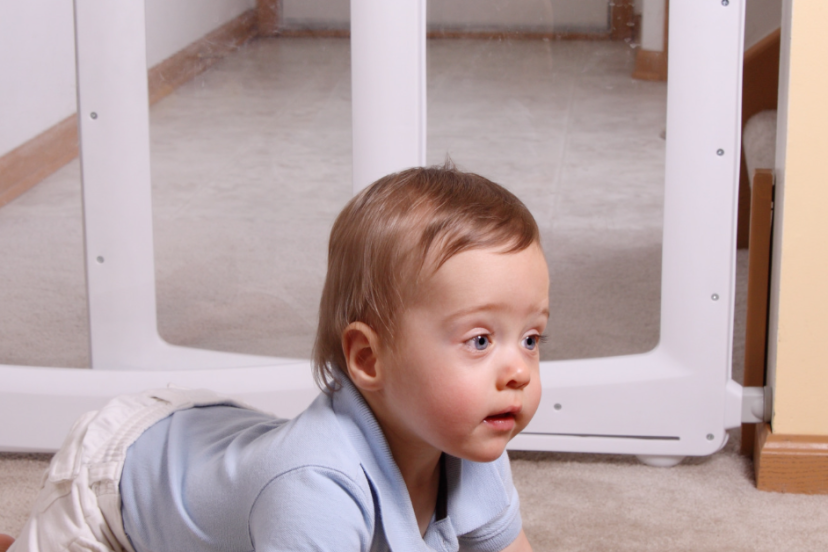The Importance of Choosing a Safety First Baby Gate: Key Factors to consider
As a devoted advocate of baby safety, I’m excited to share with you valuable insights and suggestions about a crucial safety measure for baby gates. In this article, we will explore the importance of baby safety, understand safety first baby gates, discuss how to choose the right gate, and provide practical tips for ensuring their effectiveness. Let’s dive in!
The Importance of Baby Safety
When it comes to our little ones, their safety is our top priority. As babies start to crawl and explore their surroundings, it’s essential to create a secure environment that minimizes potential hazards. Baby gates play a vital role in preventing accidents and creating designated safe spaces for our curious adventurers. Wether your loved one is sleeping on a floor bed or Crib, it is always essential to ensure you block out areas that could be potential hazards to your baby.
Understanding Baby Gates
Baby gates are specially designed barriers that prevent babies and toddlers from accessing areas that may pose risks, such as staircases, kitchens, or rooms with delicate objects. These gates act as protective boundaries, allowing parents to have peace of mind knowing their child’s movements are limited to safe zones.
Choosing the Right Baby Gate
Selecting the appropriate baby gate requires careful consideration of your home’s layout and specific needs. Here are some factors to keep in mind:
1. Measurements:
Take accurate measurements of the areas where you plan to install the baby gate to ensure a proper fit.
2. Type of Gate:
Consider the different types of baby gates available, including pressure-mounted gates, hardware-mounted gates, and retractable gates.
Each type offers unique features and installation requirements.
3. Material and Durability:
Look for gates made from sturdy materials such as metal or wood that can withstand the wear and tear of daily use.
4. Gate Height:
Opt for a gate that is at least 22 inches tall to prevent climbing and ensure your baby’s safety.
5. Locking Mechanism:
Choose a gate with a reliable locking mechanism that is easy for adults to operate but secure enough to prevent the baby from opening it.
Types of Baby Gates
Baby gates come in various styles to suit different needs.
Let’s explore the most common types:
1. Pressure-Mounted Gates:
These gates use pressure to stay in place and are suitable for areas without the risk of falling, such as doorways and between rooms.
2. Hardware-Mounted Gates:
Installed using screws and brackets, these gates provide a more secure barrier, making them ideal for the top of staircases or areas where falling hazards exist. 3.
3. Retractable Gates:
These gates feature a retractable mesh or fabric barrier that can be easily pulled across an opening when needed and retracted when not in use.
They offer convenience and flexibility in terms of installation and portability.
Installation and Setup
Proper installation of a baby gate is crucial to ensure its effectiveness and safety.
Follow these steps for a secure installation:
1. Read the Instructions:
Carefully read and understand the manufacturer’s instructions before starting the installation process.
2. Choose the Right Location:
Identify the areas that require a baby gate, such as staircases or doorways. Ensure there are no tripping hazards or sharp edges nearby.
3. Prepare the Gate:
Adjust the gate to the correct width according to the measurements taken earlier.
4. Mounting Options:
For hardware-mounted gates, use screws and brackets to secure them to the wall or banister. Pressure-mounted gates require pressure against the walls or door frames for stability.
5. Test the Gate:
Once installed, give the gate a firm shake to ensure it is securely in place and won’t dislodge easily.
Five Considerations & Safety Features
When choosing a baby gate, look for the following features and considerations to maximize safety:
1. Double-Locking Mechanism:
Select gates with a double-locking mechanism that requires two separate actions to open, preventing accidental openings by curious toddlers.
2. Vertical Slats or Mesh:
Gates with vertical slats or a mesh design are preferable to prevent a child from climbing or getting stuck.
3. Smooth Edges:
Ensure the gate has smooth edges without any sharp or protruding parts that could harm your child.
4. Slam-Shut Feature:
Some gates have a slam-shut feature, which automatically closes and locks the gate when released, offering convenience for busy parents.
5. JPMA Certification:
Look for baby gates that are certified by the Juvenile Products Manufacturers Association (JPMA) to ensure they meet safety standards.
Baby Gate Placement
Strategic placement of baby gates is essential for maintaining a safe environment for your little one.
Consider the following guidelines:
1. Staircases:
Install gates at the top and bottom of staircases to prevent falls. Ensure they are securely mounted and cannot be pushed or easily dislodged.
2. Kitchen and Cooking Areas:
Use gates to block access to the kitchen, especially when cooking or handling hot objects. This prevents accidents and keeps your child away from potential dangers.
3. Bathroom and Laundry Areas:
Install gates to keep your child away from the bathroom or laundry areas, where hazardous substances or objects may be within reach.
Regular Maintenance
To ensure the continued safety and effectiveness of your safety first baby gate, regular maintenance is crucial.
Follow these maintenance tips:
1. Check for Damage:
Inspect the gate regularly for any signs of damage, such as broken parts, loose screws, or worn-out components. Replace or repair as needed.
2. Keep the Path Clear:
Ensure there are no objects or toys near the gate that could be used as climbing aids or tripping hazards.
3. Clean Regularly:
Clean the gate periodically to remove dust, dirt, or sticky substances that may interfere with its proper functioning.
Tips for Ensuring Baby Gate Safety
Here are some additional tips to enhance the safety and effectiveness of your baby gate:
1. Supervision is Key:
Remember, a baby gate is a barrier, not a substitute for supervision. Always keep an eye on your child, especially when they are near a gate.
2. Educate Older Siblings:
If you have older siblings, teach them about the importance of keeping the gate closed and ensuring their younger sibling’s safety. Encourage responsible behavior and explain the potential risks of leaving the gate open.
3. Regularly Reassess and Adjust:
As your baby grows and develops new skills, regularly reassess the gate’s height, lock, and overall effectiveness. Make any necessary adjustments to maintain a secure environment.
4. Teach Safe Gate Usage:
As your child grows older, teach them how to use the gate safely. Show them how to open and close it properly and explain why it’s important to respect the boundaries set by the gate.
5. Supplement with Babyproofing:
While safety first baby gates are an excellent tool, they should be used in conjunction with other babyproofing measures. Secure cabinets, cover electrical outlets, and remove potential hazards from your child’s reach.
Benefits of Baby Gates for safety
Investing in baby gates offers numerous safety benefits, including:
1. Accident Prevention:
Baby gates create a secure environment and prevent accidents such as falls down stairs or access to hazardous areas.
2. Peace of Mind:
Knowing that your child is safely contained within designated areas allows you to relax and attend to other tasks without constant worry.
3. Promotes Independence:
Baby gates offer a safe space for your child to explore and play independently while keeping them away from potential dangers.
4. Flexibility and Portability:
Many baby gates are designed to be easy to install, remove, and relocate, providing flexibility and convenience for different
spaces and situations.
5. Versatile Use:
Baby gates can be used not only for stairs but also for blocking access to rooms, hallways, or specific areas of the house.
Alternatives to Baby Gates
While baby gates are an effective solution, there are alternative methods to create a safe environment for your child:
1. Door Handle Covers:
Install door handle covers to prevent your child from entering certain rooms or areas.
2. Furniture Anchors:
Secure heavy furniture, such as bookcases or cabinets, to the wall to prevent tipping.
3. Safety Netting:
Use safety netting or mesh to block off larger openings, such as balconies or wide staircases.
4. Cordless Window Coverings:
Replace window blinds or coverings with cordless options to eliminate potential choking hazards.
5. Supervision and Babyproofing:
The most critical aspect of child safety is constant supervision and thorough babyproofing of your home. Remove small objects, secure loose cords, and create a safe environment that reduces potential risks.
Conclusion
Ensuring your child’s safety is paramount, and safety first baby gates are a valuable tool in creating secure spaces within your home. By choosing the right gate, installing it properly, and implementing additional safety measures, you can provide your child with a protected environment to explore and play. Remember, regular maintenance, supervision, and ongoing assessment are essential to maintaining the effectiveness of the baby gate. Embrace the peace of mind that comes with knowing your little one is safe, and enjoy the precious moments of their early development.
FAQs
1. Can baby gates be used in rental homes or apartments?
Yes, baby gates are designed to be temporary and don’t require permanent installation. Pressure-mounted gates are a popular choice for rental homes as they can be easily installed and removed without damaging the walls.
2. Are baby gates adjustable in width?
Yes, most baby gates are adjustable in width. They often come with extendable panels or adjustable mechanisms to fit various doorways, staircases, or openings of different sizes.
3. Can baby gates be used at the top of stairs?
Yes, baby gates specifically designed for staircases, known as hardware-mounted gates, are suitable for installation at the top of stairs. These gates provide a secure barrier that can withstand the pressure and potential hazards of staircases. Ensure you hire a professional to avoid accidents caused by incorrect installation of baby gates.
4. At what age can I stop using baby gates?
The appropriate age to stop using baby gates varies for each child. That said, I recommended to use them until your child is able to walk confidently navigate stairs and understand potential dangers in their surroundings. However, it’s important to assess your child’s individual development and safety awareness before removing the gates.
5. Can I use baby gates outdoors?
This depends with the model, make and purpose of the gates, with baby gates primarily designed for indoor use. Ensure the outdoor ones are weatherproof, durable, and suitable for you specific outdoor environment.
6. Are baby gates difficult to install?
The ease of installation depends on the type of baby gate. Pressure-mounted gates are generally easier to install as they don’t require drilling or permanent fixtures. Hardware-mounted gates may require more effort and tools for proper installation, especially when mounting them to the wall or banister.
7. Are baby gates suitable for pets as well?
Baby gates can serve as pet gates too, depending on their design and height. However, it’s important to consider the specific needs and behaviors of your pets to ensure they are safely contained.
Remember, always refer to the specific instructions provided by the manufacturer for the installation, usage, and maintenance of your baby gate. Baby gates are merely a precautionary and not to be relied on entirely and should be monitored at all times.
*We may earn a commission from purchases made through our links, at no cost to you. This does not affect our product recommendations. Please see our disclosure to learn more.



